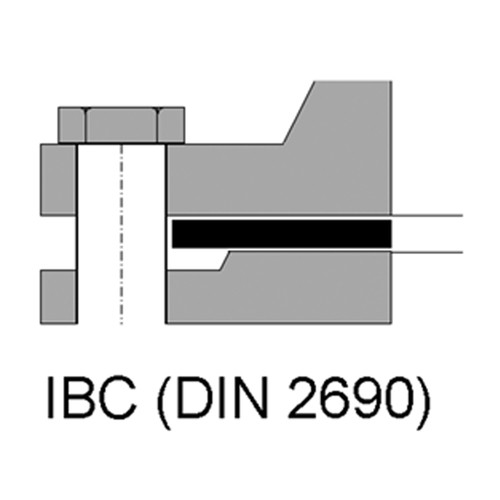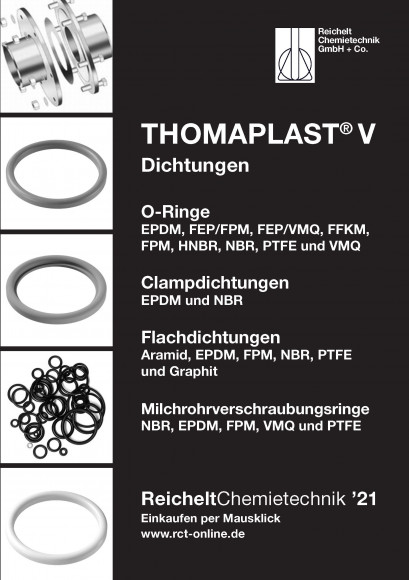High-Performance Graphite Flat Seals
Application area
Almost universally usable (depending on pressure and temperature); cover the full range of classic flat seals
Not usable in ozone- and fluorine-containing media
Product specification
Graduated gasket material of expanded graphite (purity min. 98 %)
Acid-proof expanded metal inlay made of chrome-nickel steel
Adhesive-free
Binderless
Filler-free
Resistant to almost all organic and anorganic acids, alkalis, oils and solvents
Technical specification
Color: graphite gray
Binding material: no
Metal insert: chrome-nickel steel (material no. 1.4404)
Density: 1.40 g/cm3 (DIN 28090-2)
Tensile strength: 25 N/mm2 (MD); 10 N/mm2 (CD) (DIN 52910)
Pressure resistance: 45 N/mm2 (+175 °C); 43 N/mm2 (+300 °C) (DIN 52913)
Compressibility: 30 % (ASTM F 36 J)
Recovery: 20 % (ASTM F 36 J)
Cold compressibility KSW: 25 - 35 % (DIN 28090-2)
Cold recovery KRW: 3.5 - 5 % (DIN 28090-2)
Hot creep WSW/300: <5 % (DIN 28090-2)
Hot recovery WRW/300: >3 % (DIN 28090-2)
Recovery R: 0.065 mm (DIN 28090-2)
Leakage TA-Luft: (VDI 2200 draft)
Component testing: 30 Mpa, +300 °C, 1 bar helium 0.0001 mbar*l/m*s
Chlorine content: total: 300 ppm (Siemens AV 9-014), water-soluble: 50 ppm (Siemens AV 9-014)
Fluoride content: 300 ppm (Siemens AV 9-014)
Temperature range: -240 to +550 °C (depending on pressure)
Max. operating pressure: 200 bar (depending on temperature)
Regulations: German TA-Luft certification, Firesafe (API607 / BS6755), BAM (O2: +200 °C / 130 bar), DVGW
General Information
Flat seals are usually stamped as rings. For more complicated geometries, the rings are frequently cut by means of plotter or water jet. Rings are defined by the dimensions of the internal and external diameter as well as by the total thickness of the ring but often also by nominal diameter and pressure stage according to DIN 2690, 2691 (or 2692). For the purpose of harmonizing standards, these former flat seal standards are summarized in the EU standard DIN.
EN 1514-1. Still, the following sub-descriptions serve the purpose of illustrating the individual shapes: former DIN 2690: now EN 1514-1 Form IBC for smooth flanges; former DIN 2691: now EN 1514-1 Form TG for flanges with groove and tongue.
Advantages compared with other sealing elements:
symmetrical cross section, simple compact design, easy installation, wide selection of materials, grooving not required
Most common application: Flange sealing against liquid or gaseous media; static or quasistatic applications only.
Further applications: Housing and cover sealings.
Method of operation: The flat seal is axially pressed when mounting. The axial press force has to be greater than the sum of all radially acting forces to eliminate the risk of leakage. Cross-sectional leakage (the leakage diffused through the sealing material) is minimized by the selection of the right material. An optimal grouting of the flat seal prevents surface leakage, i.e. leakage occurring between flange and seal.
Materials for special requirements:
These flat seals are especially suited for use in processes that must comply with TA-Luft requirements.
Form IBC for smooth flanges: NW 10 to 200, PN 2.5 to 63
Form TG for flanges with groove and tongue: NW 10 to 200, PN 10 to 160
Manufacturing: according to the latest standards, with an optimal tool park, for quick and flexible handling, the traceability of materials is guaranteed, all parts go through a quality check before packaging.
| Item | Image | Design1 |
Innen-Ø mm
|
Außen-Ø mm
|
Höhe mm
|
NW mm
|
PN bar
|
Einheit Stück
|
Price Euro* | Buy |
|---|
Item
|
Image
|
Design1
|
Innen-Ø mm
|
Außen-Ø mm
|
Höhe mm
|
NW mm
|
PN bar
|
Einheit Stück
|
Price Euro* |
Buy
|
|---|---|---|---|---|---|---|---|---|---|---|
| 409424 |
|
IBC | 18 | 39 | 2 | 10 | 6 | 10 | 103.00 | |
| 409425 |
|
IBC | 18 | 39 | 2 | 10 | 6 | 20 | 172.00 | |
| 409426 |
|
IBC | 18 | 46 | 2 | 10 | 40 | 10 | 103.00 | |
| 409427 |
|
IBC | 18 | 46 | 2 | 10 | 40 | 20 | 172.00 | |
| 409428 |
|
IBC | 18 | 56 | 2 | 10 | 63 | 10 | 103.00 | |
| 409429 |
|
IBC | 18 | 56 | 2 | 10 | 63 | 20 | 172.00 | |
| 409430 |
|
IBC | 22 | 44 | 2 | 15 | 6 | 10 | 111.00 | |
| 409431 |
|
IBC | 22 | 44 | 2 | 15 | 6 | 20 | 185.00 | |
| 409432 |
|
IBC | 22 | 51 | 2 | 15 | 40 | 10 | 111.00 | |
| 409433 |
|
IBC | 22 | 51 | 2 | 15 | 40 | 20 | 185.00 | |
| 409434 |
|
IBC | 21 | 61 | 2 | 15 | 63 | 10 | 111.00 | |
| 409435 |
|
IBC | 21 | 61 | 2 | 15 | 63 | 20 | 185.00 | |
| 409436 |
|
IBC | 27 | 54 | 2 | 20 | 6 | 10 | 133.00 | |
| 409437 |
|
IBC | 27 | 54 | 2 | 20 | 6 | 20 | 221.00 | |
| 409438 |
|
IBC | 27 | 61 | 2 | 20 | 40 | 10 | 133.00 | |
| 409439 |
|
IBC | 27 | 61 | 2 | 20 | 40 | 20 | 221.00 | |
| 409440 |
|
IBC | 25 | 72 | 2 | 20 | 63 | 10 | 133.00 | |
| 409441 |
|
IBC | 25 | 72 | 2 | 20 | 63 | 20 | 221.00 | |
| 409442 |
|
IBC | 34 | 64 | 2 | 25 | 6 | 5 | 98.00 | |
| 409443 |
|
IBC | 34 | 64 | 2 | 25 | 6 | 10 | 171.00 | |
| 409444 |
|
IBC | 34 | 71 | 2 | 25 | 40 | 5 | 98.00 | |
| 409445 |
|
IBC | 34 | 71 | 2 | 25 | 40 | 10 | 171.00 | |
| 409446 |
|
IBC | 30 | 82 | 2 | 25 | 63 | 5 | 98.00 | |
| 409447 |
|
IBC | 30 | 82 | 2 | 25 | 63 | 10 | 171.00 | |
| 409448 |
|
IBC | 43 | 76 | 2 | 32 | 6 | 5 | 118.00 |


























